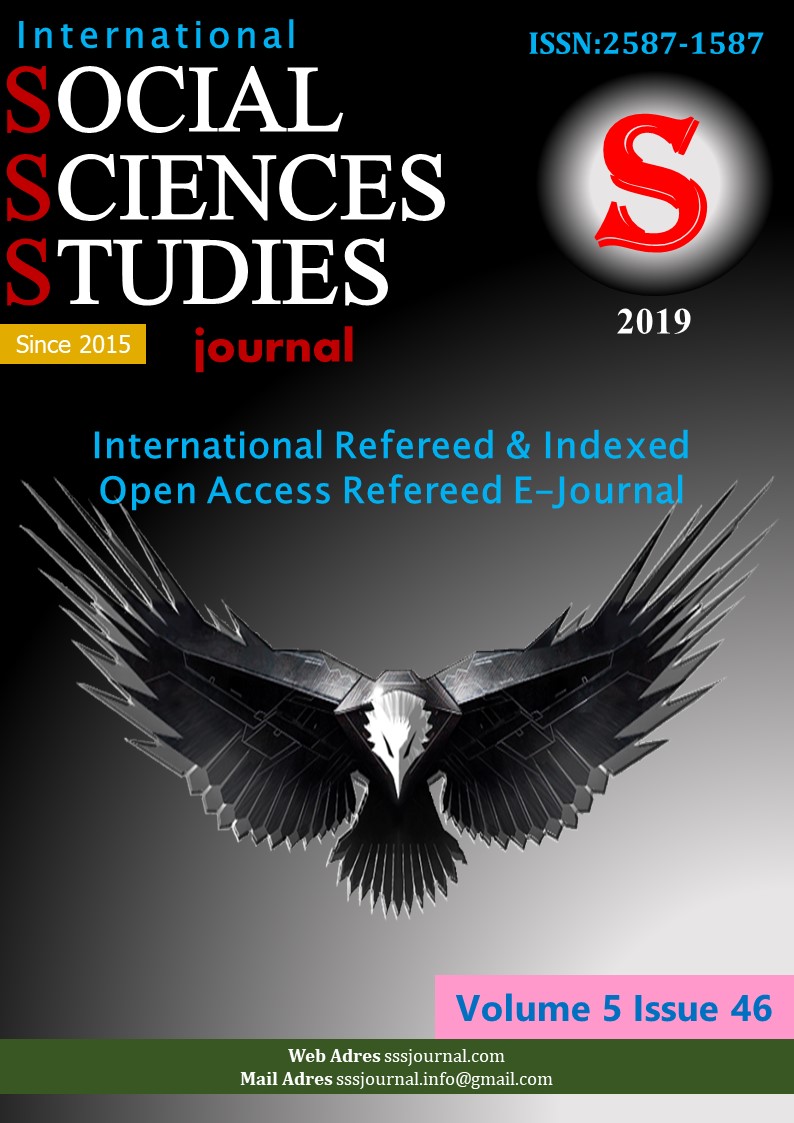Author :
Abstract
Yaşlı bireylerin nüfus oranı hem ömürlerinin artması hem de doğurganlık hızındaki düşüş nedeniyle dünya genelinde hızla artmaktadır. Bu nedenle önemli bir hedef kitle haline gelen yaşlı tüketicilerin paraya karşı tutumlarının belirlenmesi ile satın alma karar süreci ve yaşam doyumuna etkisinin ortaya koyulması amaçlanmaktadır. Araştırmanın örneklemi Ankara ilinde bulunan ve kendi geliri olan, parasını kendi yöneten 65 yaş ve üstü tüketicilerden oluşmaktadır. Çalışmanın verileri anket aracılığıyla toplanmış ve 120 katılımcı ile görüşülmüştür. Çalışma kapsamında veriler yaşam doyumu ölçeği, para tutumu ölçeği ve satın alma karar süreci ölçeği ve demografik bilgi formundan oluşan soru formu ile toplanmıştır. Hiyerarşik regresyon analizi sonuçlarına göre, yaşlı tüketicilerin yaşları ile yaşam doyumları ve paraya ilişkin tutumun güvensizlik alt boyutu ile yaşam doyumları arasındaki ilişkide yaşlıların satın alma kararlarının aracılık ettiği ortaya koyulmuştur. Araştırmada 65 ve üstü tüketicilerin yaşam doyumunun yaşa göre değişebileceği ve yaşın satın alma kararlarının etkili olduğu; para tutumunun alt faktörü olan güvensizlik ile yaşam doyumu arasındaki ilişkide satın alma kararının aracılık ettiği sonucuna ulaşılmıştır.
Keywords
Abstract
The proportion of elderly individuals due to both an increase in their lifespan and a decline in the rate of fertility is frequently increasing in worldwide. Consequently, it is aimed to determine the attitude toward money of the older consumers, who have become an important target group, and to reveal the effects of consumer decision making process and life satisfaction. The sample comprised 120 older people (≥65 years old) who have income, manage income themselves and resided in Ankara City, Turkey. The study's data were collected through a questionnaire and interviewed with 120 participants. Otherwise, life satisfaction, money attitude and consumer decision making and demographic information form were collected. According to hierarchical regression results, consumer decision making moderates the relationship between older consumers age and life satisfaction. In addition to this, it moderates between distrust (sub-scale of money attitude) and life satisfaction. The findings of the present study indicate that among consumers who are 65 and above, life satisfaction transforms with age and consumer decision making moderate between them. On the other hand, there is correlation between distrust which is sub-scale of money attitude and life satisfaction, and consumer decision making moderate between it.
Keywords
- Amatulli, C., Guido, G., & Nataraajan, R. (2015). Luxury purchasing among older consumers: exploring
- Amatulli, C., Guido, G., & Nataraajan, R. (2015). Luxury purchasing among older consumers: exploringinferences about cognitive Age, status, and style motivations. Journal of Business Research, 68(9), 1945- 1952. doi:10.1016/j.jbusres.2015.01.004
- Dean, M., Grunert, K. G., Raats, M. M., Nielsen, N. A., & Lumbers, M. (2008). The impact of personalresources and their goal relevance on satisfaction with food-related life among the elderly. Appetite, 50(2- 3), 308-315. doi:10.1016/j.appet.2007.08.007
- Diener, E., Emmons, R. A., Larsen, R. J., & Griffin, S. (1985). The satisfaction with life scale. Journal of personality assessment, 49(1), 71-75. doi:10.1207/s15327752jpa4901_13
- Diener, E., Suh, E. M., Lucas, R. E., & Smith, H. L. (1999). Subjective well-being: Three decades of progress. Psychological bulletin, 125(2), 276.
- Durvasula, S., & Lysonski, S. (2007). Money attitudes, materialism, and achievement vanity: An investigation of young Chinese consumers’ perceptions. Consumer Markets and Marketing, 497-499.
- Jerzyk, E. (2013). Retromarketing–nostalgia for the past. The sources the success of retromarketing in thesegment of older consumers. Вісник Національного університету Львівська політехніка. Логістика(762), 62-66.
- McFadden, D. (1986). The choice theory approach to market research. Marketing science, 5(4), 275-297.
- McKnight, D. H., Choudhury, V., & Kacmar, C. (2002). The impact of initial consumer trust on intentionsto transact with a web site: a trust building model. The journal of strategic information systems, 11(3-4), 297-323. doi:10.1016/S0963-8687(02)00020-3
- Moschis, G. P., & Mathur, A. (2006). Older consumer responses to marketing stimuli: the power of subjective age. Journal of Advertising Research, 46(3), 339-346. doi:10.2501/S0021849906060326
- Muringai, V., Goddard, E., Bruce, H., Plastow, G., & Ma, L. (2017). Trust and Consumer Preferences forPig Production Attributes in Canada. Canadian Journal of Agricultural Economics/Revue canadienne d'agroeconomie. doi:10.1111/cjag.12138
- OECD. (2014). Elderly population. Retrieved 02.06.2018 https://data.oecd.org/pop/elderly-population.htmSachdeva, R. (2015). A Scale to Assess the Efficacy of Consumer Decision Making. IUP Journal of Marketing Management, 14(2), 7-25.
- Salthouse, T. (2012). Consequences of age-related cognitive declines. Annual review of psychology, 63, 201-226. doi:10.1146/annurev-psych-120710-100328
- Simanjuntak, M., & Rosifa, A. S. (2016). Self-esteem, money attitude, credit card usage, and compulsivebuying behaviour. Economic Journal of Emerging Markets, 8(2), 128-135. doi:10.20885/ejem.vol8.iss2.art5
- Stewart, K., & Cunningham, I. (2017). Examining Consumers' Multiplatform Usage And Its Contributionto Their Trust in Advertising: The Impact of the Device on Platform-Use Frequency And Trust inAdvertising across Platforms. Journal of Advertising Research, 57(3), 250-259. doi:10.2501/JAR-2017-003Sudbury-Riley, L., & Edgar, L. (2016). Why Older Adults Show Preference for Rational Over EmotionalAdvertising Appeals: A UK Brand Study Challenges the Applicability Of Socioemotional Selectivity Theory to Advertising. Journal of Advertising Research, 56(4), 441-455. doi:10.2501/JAR-2016-048
- Tongren, H. N. (1988). Determinant behavior characteristics of older consumers. Journal of Consumer Affairs, 22(1), 136-157.
- Turkish Statistical Institute. (2018). Gelir ve Yaşam Koşulları Araştırması. Retrieved 05.07.2018 www.tuik.gov.tr/PdfGetir.do?id=24579s
- Turkish Statistical Institute. (2018). Elderly Population. Retrieved 05.07.2018 www.tuik.gov.tr/PdfGetir.do?id=27595
- United Nation. (2017). World Population Prospects The 2017 Revision. Retrieved 12.07.2018 https://esa.un.org/unpd/wpp/publications/Files/WPP2017_KeyFindings.pdf
- Yamauchi, K. T., & Templer, D. J. (1982). The development of a money attitude scale. Journal of personality assessment, 46(5), 522-528. doi:10.1207/s15327752jpa4605_14
- Yang, F., Gu, D., & Mitnitski, A. (2016). Frailty and life satisfaction in Shanghai older adults: The roles of age and social vulnerability. Archives of gerontology and geriatrics, 67, 68-73.
- Yang, Z., Zhou, N., & Chen, J. (2005). Brand choice of older Chinese consumers. Journal of International Consumer Marketing, 17(4), 65-81.
- Yoon, C., Cole, C. A., & Lee, M. P. (2009). Consumer decision making and aging: Current knowledge and future directions. Journal of Consumer Psychology, 19(1), 2-16. doi:10.1016/j.jcps.2008.12.002
- Yoon, C., Laurent, G., Fung, H. H., Gonzalez, R., Gutchess, A. H., Hedden, T., . . . Peters, E. (2005).Cognition, persuasion and decision making in older consumers. Marketing Letters, 16(3-4), 429-441. doi:10.1007/s11002-005-5903-3





